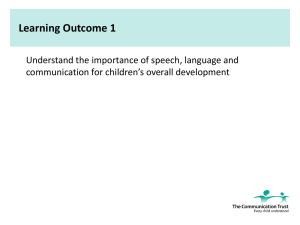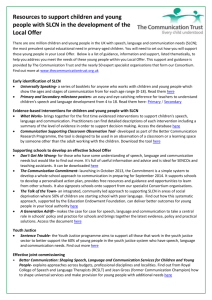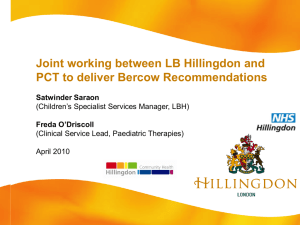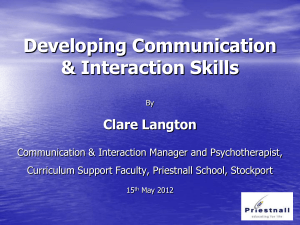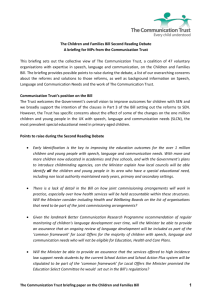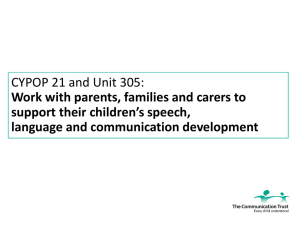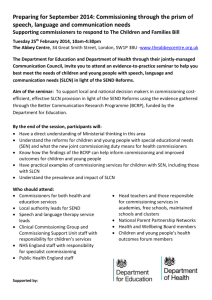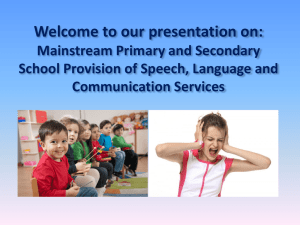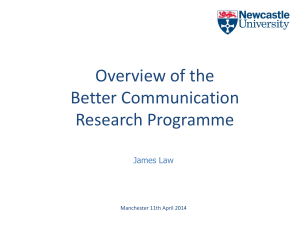Learning Outcome 1 - The Communication Trust
advertisement
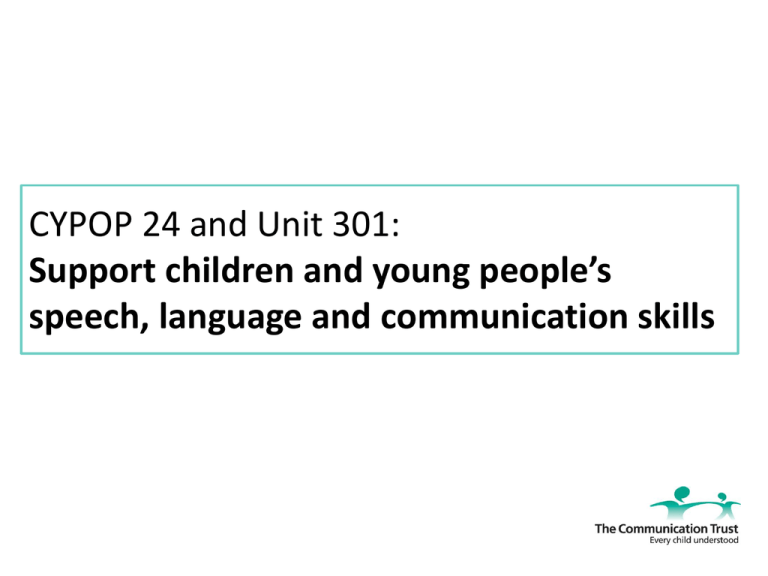
CYPOP 24 and Unit 301: Support children and young people’s speech, language and communication skills Learning Outcome 1 Understand the importance and the benefits of adults supporting the speech, language and communication development of children and young people Pre-unit activity • Arrange to watch an activity in your setting for a short period of time; approximately 2-3 minutes • You may find a structured observation sheet useful for this • Make a note of the activity and who was involved • Write down as much as you can of the language of the adult and the language of the child or young person • Audio recording will help you to do this accurately but you will need appropriate permissions Pre-unit activity Follow up and reflection • • • • • How many questions did the adult ask? Who said the most? How long were the child’s sentences? How well did the child understand? What helped support speech, language and communication? Why is it important to support and extend children and young people’s speech, language and communication development? • Speech, language and communication skills are vital building blocks for other areas of their development • Speech, language and communication are central to children and young people’s ongoing development into adulthood • The impacts for children and young people who have difficulties with speech, language and communication are many and varied Speech, language and communication skills continue to be central to development and learning Play Reading & writing Learning Social Speech, language & communication Behaviour Emotional Thinking Problemsolving Activity 1a The positive effects of adults supporting speech, language and communication Speech, language and communication Play Learning Social development Literacy Behaviour Emotional development Self confidence Thinking and problem-solving Activity 1b How can you support and extend children and young people’s speech, language and communication? Different ways to support & extend SLC What affects speech, language and communication development? Research evidence shows… • The amount of • The more they hear, the more time their parents spend talking with them and the more types of language words they are exposed to, the more children use children hear is important • Children seem to develop strong language skills when parents ask open-ended questions, ask • What adults say children to elaborate, and focus on topics of interest to children is to the child. Responding to what the child is talking also important about and having familiar routines also promote shared understanding. • Co operative • Conversations about how people feel and how that interactions are affects what they do, are important in learning very important social communication skills Discussion point 1 • The evidence on the previous page is from a study looking at the way parents supported their children's speech, language and communication development. • Which of the points do you think are also relevant for people who work with children and young people and why? Activity 1c Quick quiz 1. When can you support speech, language and communication? 2. When should you extend speech, language and communication • • • • • • Any time – all the time! In everyday routines and conversations In all activities, play and social times Set up specific opportunities/ activities 1:1 and in groups When children are talking with you or with other children • Use your judgement, based on knowing the child and what they need • Where you can and it’s appropriate Key principles • Listen to and value the contributions of children and young people • Consider their level of development – where they are now and where next • Model good communication • Make language learning fun • Work with parents and carers • Include speech, language and communication in your planning • Make the most of opportunities throughout the day • Keep an eye and make a note Key principles – children and young people learning more than one language • The principles of ways to support and extend children’s speech, language and communication apply to just the same children and young people learning more than one language • Bilingualism is an asset • Home language has an important and continuing role • As with developing a first language, understanding is in advance of talking. • Language diversity should be acknowledged and celebrated • The demands on children and young people who are learning English as a second language should be recognised and considered Ways to support and extend speech, language and communication • There are 5 areas in this section, looking at some of the different ways adults support and extend speech, language and communication 1. Supporting speech, language and communication of babies 2. Supporting speech, language and communication of young children 3. Some ways to support speech 4. Some ways to support language – adapting and scaffolding 5. Some ways to support communication • You’ll need refer to different age ranges in your portfolio Supporting the speech, language and communication of BABIES • Attachment is crucial to support communication development • Give babies time to process and respond • Opportunities for early communication – eye contact, sound-making, turn-taking • Using ‘parentese’ • Rhymes and songs • Shared attention • Running commentary for every day events Activity 1d - Supporting the speech, language and communication of YOUNG CHILDREN Learning to Talk, Talking to Learn has 10 top tips: 1. Get the child’s attention first 2. Make learning Fun 3. Use simple repetitive language 4. Build on what the child says to you 5. Demonstrate rather than criticise 6. Imitate the child’s language 7. Use all the senses to teach new words 8. Give the child time to respond 9. Be careful with questions 10. Use the full range of expression Activity 1d - Supporting the speech, language and communication of YOUNG CHILDREN • Choose a technique. Discuss with a partner your thoughts about this technique • If you work with young children, which of the techniques do you currently use? • Choose one technique you haven’t used before and make a plan to use it in your setting. • When you have tried this out, discuss with your group how you used the technique and how effective it was and make a comment in your portfolio Ways to support and extend children and young people’s speech, language and communication There are many ways to support and extend children’s speech, language and communication. Adults can support and extend them: In everyday routines and conversations In activities and events that are happening anyway In specifically planned activities In 1:1, pairs and groups When children are talking with you or with other children Supporting and extending children’s SPEECH – a few ideas • • • • Develop awareness of sounds in the environment Encourage good listening skills Play around with rhymes Make sound pictures or have a sound table, with pictures or objects which start with the same sound • Model the right response rather than correcting their speech – “I taw a tat” – “you saw a cat? How exciting..!” Transfer into practice 1 Think of an activity which already happens in your setting. Think of one way you could support a child’s speech through that activity Think of how a you could suggest a parent could support their child’s speech Supporting children and young people’s LANGUAGE • Language includes talking and understanding. Adapt your language Scaffold their language Activity 1e - Adapting your language In small groups, listen to and have a look at the following information and the question which follows it. (Don’t worry, it’s meant to be complicated!) Then think about the five questions below • How easy is it to understand? • What makes this the case? • Could you answer the question? • How ‘good’ was this question? • How did you feel about the activity? Activity 1e - Adapting your language Epistemology is generally characterised by a division of two competing schools of thought: rationalism and empiricism. The rationalists sought to reconstruct critically the total of human knowledge by the employment of such ‘pure’ reasoning from indubitable axioms. The empiricists took direct acquaintance with the ‘impressions’ of senseexperience as their bedrock of infallible knowledge Q1: Was rationalism one of the schools of thought? Adapting your language – key things to think about How much you talk How many and what questions you ask What spaces there are for children to talk How long your sentences are Adapting your language How much time children have to think about what you say How complicated your sentences are How many new or complex words there are Adapting your language - questioning Too many questions and certain types of questions can inhibit language and communication Children may not join in They only give answers May say less Quality may be lower Fewer opportunities to talk with others Less opportunity for exploring and expanding thinking and language • Try to comment, not question • Think about question types Activity 1f - Adapting your language- Exploring different ways of talking with children This is from a research study looking at 5 different ways of supporting and extending talking. • For each one, consider… • How well does the approach support and extend the child’s language? • How could the adult improve their questioning or interaction? • How often do you currently use each approach in your talk with children? Activity 1f Interaction style What was child’s Does this Why/ why not language like? work? Enforced questions Two-choice questions Wh questions Personal contributions Phatics 1 Enforced repetitions Child says: ‘biscuit’ Adult says: ‘say “please can I have a biscuit” Child says: ‘biscuit’ 2 Two choice questions • The adult asks the child a question where there are only two choices – this includes either yes/no answers or ‘forced alternatives’ Adult: ‘Is that an elephant?’ Child: ‘no’ OR Adult: Is that an elephant or a giraffe? Child: ‘Giraffe’ 3 – ‘wh’ questions • Adult asks a question starting why, what, when etc Adult: ‘Who’s that?’ Child: ‘daddy’ Adult: ‘where’s he going?’ Child: ‘shop’ Adult: ‘why?’ Child: ‘car’ 4 – Personal contributions • Adult avoids asking questions, but gives their personal contributions around something that the child is interested in. Adult: I went to the park at the weekend Child: Me too! Adult: I played football with Rosie Child: I played on the swings Adult: oh, I’m a bit too big for the swings Child: not me, I can go so high Adult: so high you touch the clouds… Child: even higher… 5 - Phatics • Adult tries to say nothing with any ‘content’, just “makes the right noises”. They try to avoid questions and take the child’s lead Adult: Hey, look at that… Child: It’s a princess Adult: aha… Child: she’s gonna get eaten by the dragon Adult: oh no, scary … Child: but she doesn’t taste so good Adult: yuk… Child: she tastes like slugs Adult: disgusting – even for a dragon Child: yeah, cos he likes marshmallows Activity 1f– answers – which work well? Interaction style What was child’s language like? Does this Why/ why not work? Enforced questions No different The adult’s language was too complex for the child to copy Two-choice questions Only one word answer The questions are very restricting Wh questions One word – directly answers question Can make child passive Useful if child understands question words Personal contributions Longer sentences More involved Child was interested and had time and space to make contribution Phatics Child says more than adult Lots of space for child to lead Adult leaves options open for child Starts to sound like a story Scaffolding children and young people’s language Scaffolding describes how adults provide support to enable children to achieve and develop their skills. There are many ways to do this; some examples are: • Adding to, or extending what a child says • Modelling examples • Encouraging children to rehearse and practise • Breaking tasks or skills down into smaller steps • Teaching and helping children to learn new words • Providing structures for giving information or telling stories • Using visual prompts or props Some examples of extending a child’s talking Child/young person says • There’s a bus • I can see a big spider • I can’t play football today. My leg hurts Adult says • Yes, it’s a big bus • Me too – he’s enormous • Oh, you can’t play football because your leg hurts Some examples of extending children and young people’s language - vocabulary • Teach children new words: Use all the senses – real objects if you can, or pictures if not Talk together about its shape, colour, texture Talk together about what it does, what it’s similar to, what it means Talk together about how this links to what they already know – give examples and the context Talk about the structure of the word – how many syllables it has, what it starts with Help them to use it. Reinforce the new word regularly Vocabulary Guava Starts with ‘g’ It smells, tastes, feels like… It’s juicy 2 syllables Shaped like a pear Orange colour Pips inside Fruit Grows in hot countries You eat it Supporting children and young people’s COMMUNICATION Communication skills can often be taken for granted. Some ideas: Model and demonstrate good communication skills Make skills explicit Talk about and practise communication for different situations, events and purposes Give children and young people clear roles when working in groups – eg the summariser, the note-taker, the introducer Ensure there are well structured opportunities for children and young people to communicate with each other Learning through play Discussion point 1.1 Working with parents, carers and families Why is it important to work with parents, carers and families in supporting a child or young person’s speech, language and communication? Think of three ways you could effectively work together Working with parents, carers and families some ideas Share ideas, advice, information Model ideas and examples in practice Talk about how their child is progressing Ways to work with parents Offer workshops, sessions or events Invite them to come and watch communication in action Listen to their ideas and concerns Portfolio task 1.1 • Prepare some leaflets or posters, showing how adults can support and extend children and young people’s speech, language and communication development. Make sure you include general key points as well as any for the specific age groups • Include information on the positive effects of this support too. Transfer into practice • Learning outcome 2 looks at how to put the ideas from Learning outcome 1 into practice. • Choose one of the methods you have found out about and try it out in your setting. Make a note of the context, activity and child you were working with. Note or record (with the appropriate permissions) a short section of your interaction and consider: • What you did and said: • What the child or young person did and said: • What the good parts of this method were: • What you might do differently next time: Learning outcome 2 Be able to provide support for the speech, language and communication development of children and young people Reflection on transfer into practice • Work in small groups to share experiences of trying out different methods of supporting and extending speech, language and communication in your settings. • Note down the key points from your discussion Supporting speech, language and communication development What adults do How policies and ethos reflect speech, language and communication How parents and families are involved How the environment supports communication How children and young people are involved Activity 2a – considerations for supporting speech, language and communication • When you choose ways to support children and young people’s speech, language and communication, it is important to consider a child or young person’s: Specific needs Abilities Home language Interests • In pairs, choose one of the points and discuss why it is an important consideration. Share your thoughts with other groups to cover all four. Planning how to support speech, language and communication in your practice and in your setting • Speech, language and communication can be supported through everyday routines, in conversations and activities which are happening anyway as part of your setting • Specific activities, events and games can also be planned to support speech, language and communication skills in particular • Speech, language and communication are so much part of what we do with children and young people, that it can sometimes be taken for granted • Including speech, language and communication in your planning keeps it at the forefront of your mind and firmly in your practice Planning should include 1 • How will the physical environment support speech, language and communication? • What are the roles and responsibilities of staff in supporting speech, language and communication? • How are children and young people’s views included in what you do? • How can parents, carers and families be involved in supporting speech, language and communication too? • It is also important to consider what training and development are needed to best support children and young people’s speech, language and communication Planning should include 2: • The child, young person or group you are working with • Their age • Any resources you would use • The adults involved • The activity and its aims • The methods you will use and why you are choosing them • How you will evaluate what you did Evaluation should include: • Thinking about what you did, saw and heard • Thinking about how well you felt this worked • Finding out how others thought it worked – this would include the children and young people involved, maybe colleagues and parents or carers • Thinking about what you might do differently next time Portfolio task 2.1 • Make a plan showing examples of how you will support speech, language and communication in your practice. This could either be through planning specific activities, through how you will change your everyday practice, or both • Demonstrate at least three different methods of supporting and extending speech, language and communication in your setting • Explain how effective you thought your support was, using your own evaluation and feedback from others • You could complete this activity through using a reflective diary if you wish Learning Outcome 3 • Understand how environments support speech, language and communication The environment • Communication friendly • Role • Skills, knowledge • Development • Communication central Physical Policies and ethos Adults Child/ young person • Involvement • Views Policy and ethos • It is important for settings to value speech, language and communication and to see it as a central part of what they do with children and young people • If speech, language and communication are well reflected in the policies and ethos of a setting, it can support effective practice The physical environment Space Noise levels Light Visual support Opportunities Resources • Opportunities for supporting need to happen and be effective • Clear planning to develop the environment • Actions to take this forward Activity 3a – key factors for a communication supportive environment • You could do this activity individually, in pairs or small groups • Use one of the recommended resources • Highlight the key factors it describes which provide a supportive speech, language an communication environment • Share what you have found with another person, pair or group. Adults in the environment • Learning outcomes 1 and 2 have focused on the ways in which adults can support speech, language and communication • The roles of adults working with children and young people are important, as well as their skills and knowledge. Identifying training and development needs and then meeting these is also important • Parents, carers and families should also be considered The child or young person • Children and young people are at the centre of our practice in supporting speech, language and communication development • It is essential to ensure they are fully involved and there are ways and opportunities effectively used to gain their views within your setting • This applies to all children and young people, including those who are very young or who have very limited spoken communication. Transfer into practice • Thinking of the key factors of an environment which supports speech, language and communication, what does your setting currently do well? • Identify two things which could be introduced, improved or extended • How could you go about doing this in your setting? Portfolio task 3.1 • Make a plan for an environment which effectively supports speech, language and communication. You could make a drawing or perhaps use photographs of an existing setting (with appropriate permissions if necessary) • Using relevant evidence, label your plan with the key factors which will support speech, language and communication • Include some information which explains the importance of the environment in supporting speech, language and communication Learning Outcome 4 Be able to recognise, and obtain additional support for, children and young people who have speech, language and communication needs Speech, Language and Communication Needs (SLCN) • Most children follow the expected pattern of development for their speech, language and communication at the expected times. Some, however, do not. These are described as having Speech, Language and Communication Needs - SLCN The importance of recognising children and young people with SLCN • In your group, discus why it is important to recognise children who may have speech, language and communication needs. Try to include the following ideas in your discussion. Intervention, help or support Impact Early identification Recognising children and young people who may have SLCN • Recognising children and young people is based on Having a good understanding of the ages and stages of speech, language and communication development Observing and recording what a child can do, as well as the things they may find difficult Considering speech, language and communication if a child or young person is having difficulties in ANOTHER area of their development or life Getting the views of the child, young person and their parents Using tools and resources to help you Sharing any concerns with others Children and young learning more than one language • Children and young people do not have SLCN simply because they are learning more than one language. Additional language learning is not an indicator for SLCN, nor are limited English skills, where the home language is developing as expected • However, some children who are learning more than one language will have SLCN. This is because developing speech, language and communication skills is difficult for them whatever the language and they would have difficulties whether they were learning 2 languages or one It is really important to identify these children's needs, but it can be quite difficult Every child or young person’s SLCN will be different and individual May be in one, more or all areas of SLC Will vary in terms of the level of need and the impact SLC may be the only or primary need OR part of another condition or need Skills may be delayed or disordered/ atypical May be short-term OR persistent Activity 4a George and Karim • Read the written profiles of these two boys. • Decide, for each, whether you think their needs lie in speech, language or communication or perhaps a combination • From their profiles, is there anything else which you think is particularly interesting about either boy Activity 4b Ben and Jermaine • Read the written profiles for both of these boys. One boy’s needs are part of a wider disability; one boy’s difficulties are only to do with speech, language and communication at this point • Decide which is which and discuss why • At the moment, Ben’s needs have not yet been recognised. Why is it important for Ben’s needs to be recognised as soon as possible? Indicators of SLCN Difficulties with Play Social interactions & relationships Speech Literacy Language Behaviour Communication Confidence and self-esteem May indicate Speech, Language and Communication Needs Recognising SLCN – two possible approaches Ages and stages resources • Check to see if the child is at the stage you would expect for their age • If not, see what stage they are at in the different areas of speech, language and communication • Look at ways to help and seek advice and support Indicators checklists • Using your knowledge and observations of the child or young person, highlight the behaviours on the checklist which the child/ young person shows • Seek advice and support on ways to help Activity 4c – recognising SLCN • Working in small groups, choose one ages and stages resource and one checklist • Discuss the resources in your group. Think about what they cover and how they might work to recognise if a child has speech, language and communication needs • Are there particular advantages or disadvantages for each? • Which do you think might work best in your setting and why? Raising concerns • If you work with young children, you may be the first professional to have concerns. Raising these effectively will support early identification and intervention, which are crucial to support children’s development and minimise the potential impacts • However, this may also be the case if you work with an older child or young person. • Many children and young people have had their speech, language and communication needs MISSED completely • Lots of other children and young people may have been identified as having a DIFFERENT need • For some, their difficulties only really come to light in primary or secondary school Raising concerns and gaining additional support Note examples Gain help from others (Eg SLT, SENCo) Raising concerns and getting help Add support Observe Monitor Talk to others Talk to parents, child/ young person Activity 4d - Processes and procedures • In pairs, discuss the processes and procedures in your setting for raising concerns and accessing additional support for children and young people with SLCN • What were the similarities and differences between the processes? • Based on your learning from this unit, are there ways that you feel the processes and procedures could be improved? If so, what would you suggest and how might this be implemented? Additional support for children's SLCN Who might offer additional support? In your setting (e.g. You, language lead, senior colleague, SENCO) Outside your setting (e.g. Speech and Language Therapist, SLT or teaching assistant, advisor) What might that additional support be? Changes to the environment Using interventions, approaches or strategies Further assessment Speech and Language Therapy Programmes designed by a specialist Working with other adults & support staff Training or information for staff Work with parents Portfolio task 4.1 • Prepare a briefing for a new member of staff explaining the processes and procedures to follow if there are concerns about a child or young person’s speech, language and communication in your setting • Include information on the range of SLCN that there may be and indicators which may suggest a child or young person has SLCN • Explain the processes and procedures for your setting to access additional, specialist support for children’s SLCN in your setting • Your briefing could be written or verbal. You may find it useful to use diagrams to illustrate the processes and procedures Hello 2011 is the National Year of Communication ‘Hello’ is a national campaign run by The Communication Trust, complementing the Government’s commitment to support children with speech, language and communication needs. Please visit www.hello.org.uk for more information on how you and your setting can help improve the communication skills of children and young people – so that they can live their life to the full.
